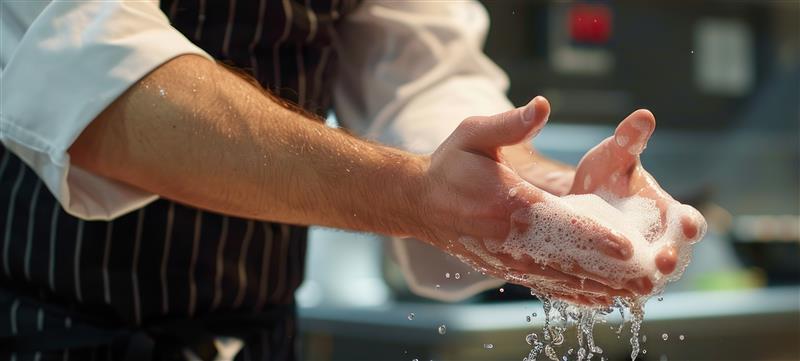Christmas is just around the corner. However, this year it’s going to feel rather different as the risk of COVID-19 infection has not abated. Because of this, it is particularly important to lessen any other risks to you and your family’s health, especially the more vulnerable.
Who is more at risk?
Each year millions of people get sick from food illnesses, some of which can cause serious health problems, such as salmonella.
Even though anyone can get sick from eating contaminated food, some people are more prone to be affected than others – those include:
- Young children
- Older adults
- Pregnant women
- People with certain health conditions like cancer, HIV/AIDS, diabetes, and kidney disease
- People that are already ill (their immune system will be compromised)
- People who suffer from allergic reactions to some foods
Ensure your food preparation is safe
Making sure your food is bacteria-free is key to avoid food-illnesses so, before you start carving the turkey and wrapping pigs in blankets, take a look at the four basic steps for ensuring your food preparation is safe.
1. Clean and Disinfect
Always make sure you:
- Wash your hands in warm soapy water for at least 20 seconds. Need a timer? Hum “Happy Birthday” to yourself twice. Do this before and after touching food
- Wash your cutting boards, dishes, forks, spoons, knives, and kitchen work tops with hot soapy water. Do this after working with each food item
- Clean and disinfect surfaces regularly, especially surfaces that come into contact with food and that are touched regularly
- Thoroughly rinse with cold water fresh fruits, vegetables, and salad items. Remember that vegetables grown in soil will also need to be peeled before use
Never use kitchen towels/washcloths more than once a day. At the end of the day, put them aside and wash with the next load of laundry. If your kitchen towels or dishcloths touch raw meat, it can cause bacterial contamination. Don’t use them again for anything else until you have washed and dried them.
Use paper towels to soak up liquids, grease or remove food waste
Clean or disinfect: What is the difference?
Cleaning means removing dirt and some germs, usually with a detergent and a thorough rinse with hot running water. For many small items (such as cutlery and crockery), this is enough to make them safe to use.
Disinfecting means and killing most of the germs present. This is important for larger or fixed surfaces where thorough rinsing is not possible, such as work tops, cooker tops, waste bins, highchairs, etc.
Regularly disinfecting the surfaces of your home is one of the best ways to prevent the spread of harmful germs and bacteria. You can do this by using an ‘Antibacterial Surface Cleanser’, like the ones that say “kills 99.9% of bacteria”. These are effective, non-bleach and no-taint sprays that will help you do the job. Remember to read the label to check the product is safe to use where food is prepared.
2. Avoid cross-contamination
Cross-contamination is what happens when bacteria or other microorganisms are unintentionally transferred from one object to another. The most common example is the transfer of bacteria between raw and cooked food which is thought to be the cause of most foodborne illness. For example, when you are preparing raw chicken, bacteria can spread to your chopping board, knife and hands and could cause food poisoning.
Even though cross-contamination can be a common issue, there are simple ways to avoid it, these include:
- Keeping raw meat, poultry, seafood, and eggs away from other foods. It is also advised that you do this in your shopping trolleys, bags for life, and fridge
- Covering and storing raw meat, poultry, fish, and shellfish on the bottom shelf of your fridge. Cooked, washed, and prepped food must always be stored above raw food items
- Using a separate chopping board for raw foods – make sure it is cleaned after every use
3. Cook
Foods need to get hot and stay hot. Heat kills bacteria.
Following cooking instructions, as well as cooking food for the correct length of time and at the right temperature are great ways to prevent food poisoning
A good way to ensure that your food is thoroughly cooked is using a thermometer to check its temperature. Food should be 75°C or above in the thickest part. This is sometimes called ‘core temperature’. Some foods change colour when they are cooked so you can check this too.
For example, when cooking a whole chicken, pierce the thickest part of the leg (between the drumstick and the thigh) with a clean knife or skewer until the juices run out. The juices should not have any pink or red in them.
The 75°C guidance covers:
- Turkey
- Chicken
- Duck and Goose
- Pork
- Minced meat products such as burgers, sausages, and kebabs
Kidneys, liver, and other types of offal should be cooked thoroughly until they are steaming hot all the way through
Meats such as steaks and joints of beef or lamb, can be served pink if the outside has been properly cooked or sealed to kill the bacteria, but that does not apply to all joints. Rolled joints need to be cooked all the way through and checked using the juices and core temperature method.
When reheating, take extra care your food is heated all the way through. Do not reheat food more than once.
4. Store foods correctly
Different foods need to be stored differently. When you buy food, check the product label and/or packaging to find out what’s the best way to store each product. Labels contain a lot of key information, including if foods need to be chilled, frozen, or kept at ambient (room temperature). Ambient products are usually canned, bottled, and dry goods.
Using frozen foods
Once you’re ready to use a food you had previously frozen make sure you thaw it:
- In the fridge
- Under cold water
- In the microwave
- Marinate foods in the fridge.
If in doubt, read any defrosting instruction given on the food packaging.
Storing cooked food
For storing foods that have just been cooked you should employ the ‘90 Minute Rule’. This means that you should put newly cooked foods in the fridge or freezer within 90 minutes after cooking (if you have not eaten it straight away), buying from the shop or having food delivered to your home.
If you would like further food safety information, have a look at the Food Standards Agency website: https://www.food.gov.uk/safety-hygiene/home-food-fact-checker



